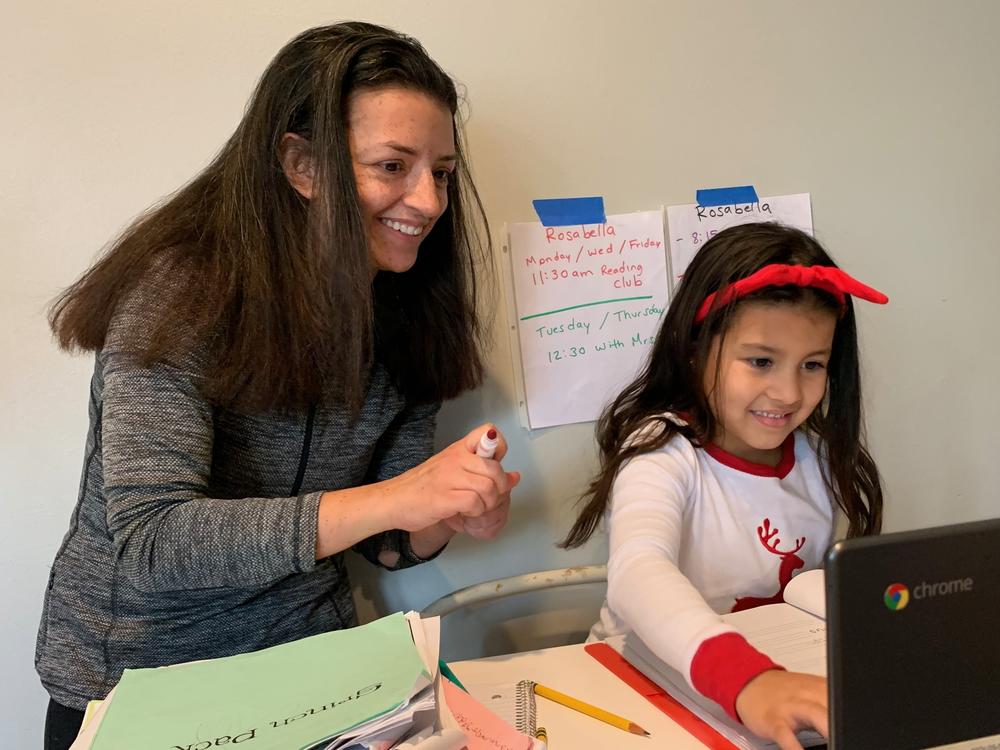Section Branding
Header Content
Parents With Disabilities Face Extra Hurdles With Kids' Remote Schooling
Primary Content
The Americans with Disabilities Act says schools have to help not just students but parents with disabilities, too, like making sure deaf or blind parents can communicate during parent-teacher conferences. But what happens when kids are learning at home? That's uncharted territory.
Rosabella Manzanares, a first grader at Betsy Ross Elementary in Forest Park, Ill., has a spelling test. Like so many kids around the country, she's taking the test at home, sharing a Zoom screen with a class full of other boisterous 6-year-olds.
Rosabella's teacher relies on parents to grade simple assignments like this. But while Rosabella can hear the spelling words, her mother can not.
Chantelly Manzanares uses American Sign Language, or ASL, which is different than English. It's a visual language. It has its own grammar. It uses different sentence structure. Rosabella and her siblings grew up using ASL. But while they've become fluent in English, Manzanares is not. She can grade this spelling test, which Rosabella holds up to the screen with a big smile. But it can be tough for Manzanares to help with other work in English.
What's more, now that the kids are home all day, Manzanares says she worries her children are missing out on the benefits of being in the physical school environment.
"So being out, hearing people speak, using their voices," says Manzanares through an ASL interpreter, "that becomes a more rich, English-rich environment."
It's also more difficult for Manzanares to keep up with what's happening during class, in case she needs to jot down a reminder or help her daughter.
"Sometimes she asks me what they're saying because she can't hear," says Rosabella. "And I tell her what they're saying."
Manzanares signs that she doesn't want to burden Rosabella with too much interpreting. Nor does teacher Peggy Perry. So, they're finding their way through it.
"A lot of times what I'll do now," says Perry, "is, before we hang up, I'll say, 'Rosabella, I want to see you tell mommy that we have science at 1:30.' And that seems to be working really well. Because we can't expect 6 year olds to remember everything, right?"
Manzanares can text Perry if she needs to. Perry has downloaded an app that lets her and Manzanares see a live ASL interpreter on screen. Manzanares says she feels more supported now than when the pandemic began. But not all parents are feeling that way.
Robyn Powell, co-investigator with the National Research Center for Parents with Disabilities at Brandeis University, says that even before the pandemic, schools haven't always lived up to their commitment to accommodate parents and caregivers with disabilities.
"So the pandemic has really, I think, exposed longstanding inequities that have always existed," says Powell, "but really the pandemic has brought them to life. And it's also shown us what we don't know."
Schools might not know, for example, how to support a blind parent or caregiver who is now expected to help her child practice her handwriting—writing she can't see.
Powell's Center recently held a Twitter chat for parents and caregivers with a range of disabilities, and she says many expressed frustration over what schools are expecting of them with online learning at home.
Powell says she can see how the ADA could be used to make an argument for providing parents more support during online learning. But the argument hasn't been tested.
Copyright 2021 NPR. To see more, visit https://www.npr.org.

